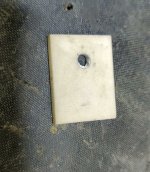That looks like either an aluminum oxide or beryllium oxide insulator, available at good distributors. I also use these when I have a project involving devices with high voltage at the collector/drain.
Beryllium oxide is poisonous/carcinogenic, so you want to get aluminum oxide insulators. I doubt that distributors even stock BeO insulators any more because of health concerns.
Beryllium oxide is poisonous/carcinogenic, so you want to get aluminum oxide insulators. I doubt that distributors even stock BeO insulators any more because of health concerns.
Back in the 1980's I worked for a video projector manufacturer and they switched from mica insulator to the stick-on grey thermal pads for their horizontal sweep transistors ( 1000V peak).
(TO-3P) the only problem was that it would arc from the mounting screw to the transistor. The fix was to use silicon grease on the screw to eliminate the arc. They went back to the cheaper mica insulators because the would still have to use silicon heat sink compound with the sil-pads.
(TO-3P) the only problem was that it would arc from the mounting screw to the transistor. The fix was to use silicon grease on the screw to eliminate the arc. They went back to the cheaper mica insulators because the would still have to use silicon heat sink compound with the sil-pads.
Thank You all for replying used in a very high voltage amplifier 250 0 250 DC +/- RAILS

 that's too much to the extreme . andrew do you have a picture of the speaker you will use with that amp?
that's too much to the extreme . andrew do you have a picture of the speaker you will use with that amp?BeO is actually very safe as long as you do not break it or machine it. The issue is BeO dust when taken into the lungs, will cause berylliosis in 4% of humans. This is a result of the beryllium replacing phosphorous in the walls of the lining of the lungs. It renders the walls inert and unable to pass oxygen through.Beryllium oxide is poisonous/carcinogenic, so you want to get aluminum oxide insulators. I doubt that distributors even stock BeO insulators any more because of health concerns.
When I last looked, there was no test capable of distinguishing which humans were susceptible. The Brush Wellman site always had very useful information, I assume they are still in business.
We use metallic beryllium, and take very stringent measures with it as the surface of the metal will oxidize creating a powder, worst possible form. It is useful because it lets x rays through while keeping air out of the vacuum components.
BeO is as conductive thermally as aluminum. Aluminum nitride is a close second, Aluminum oxide is about 1/8th of aluminum IIRC.
Jn
Last edited:
Btw, if you choose an alumina insulator, go with the thickest one you can get. Thicker will help heat spreading so that the interface to the heatsink is used more. Also, if you can use graphene sheet between the case and the insulator, that is better as well. You could also use a silver or copper loaded paste between case and insulator, just check the thermal characteristics first.
Jn
Jn
- Status
- This old topic is closed. If you want to reopen this topic, contact a moderator using the "Report Post" button.
- Home
- Amplifiers
- Solid State
- High voltage transistor insulator
